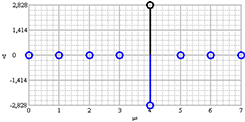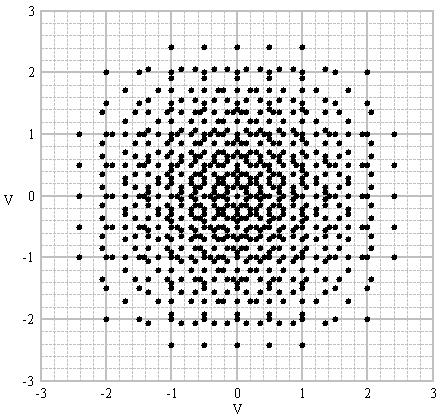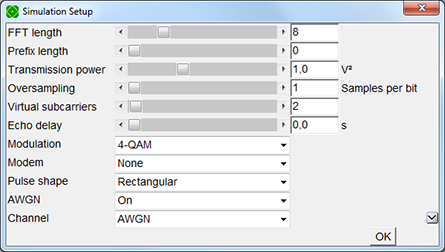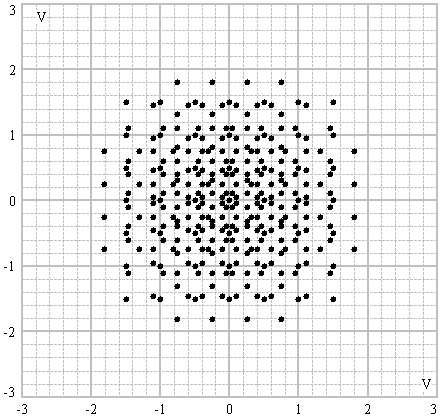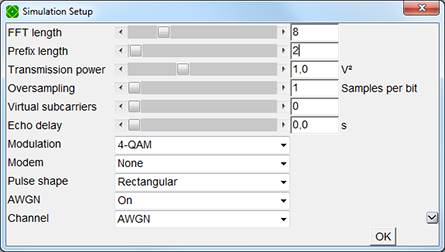Peak-to-average power ratio (PAPR) of OFDM systems
This tutorial points out that the peak power of an OFDM system is N times the average power - where N is the number of subcarriers. Thus, the PAPR of an OFDM system is N.
|
|
PAPR is the peak power divided by the average power.
|
|
PAPR of an OFDM system is N - the number of subcarriers.
Let's compare single carrier and OFDM systems. Initially both shall use QPSK modulation and transmit with a power of
. The difference is that the
OFDM transmission signal is the output of an IFFT that is power invariant normalized. The point is that the IFFT transforms some sets of QPSK symbols, i.e.
OFDM frequency domain symbols, to OFDM time symbols where all signals disappear but one, see examples in table. To keep the average power the peak
power of the remaining signal is N times the average power.
| Single Carrier QPSK symbols |
 Signals of OFDM symbol Signals of OFDM symbol |
|
Equal QPSK symbols [1, -1] |
OFDM time symbol where all signals disappear but one |
|
Alternating QPSK symbols [1, -1], [-1, 1] |
Another OFDM time symbol where all signals disappear but one |
When OFDM subcarriers add up coherently the power of the transmitted signal is N times the average power.
The Peak-to-average power ratio (PAPR) of is the number of subcarriers.
In this example, all amplitudes and the peak amplitude of QPSK are
.
Peak amplitude of OFDM is
(N = 8).
This applies to OFDM systems in general:
- OFDM adds a
on top of any preexisting PAPR.
- M-QAM: For any constellation size OFDM adds a
on top of the PAPR of M-QAM.
(N peak power QAM symbols may result in an OFDM signal with N times the peak power.)
- Quadrature modulation contributes 3 dB PAPR.
- The guard interval doesn't change the average and peak power and PAPR.
- Unused (virtual) subcarriers don't count. N is the number of used subcarriers. See experiment
- Variation of the transmit power doesn't change the PAPR.
In this experiment the Peak-to-average power ratio of OFDM systems (PAPR) is analyzed. As pointed out in the tutorial, the PAPR of an OFDM system is N, the number of subcarriers.
|
|
OFDM symbols are generated by an IFFT with size
.
Start
The simulation starts with this setup.
| Number of subcarriers, FFT size |
|
| Modulation |
4-QAM |
| Transmission power |
|
Experiment
Determine the constellation points with peak power and calculate the PAPR of this OFDM system!
OFDM transmitted signal constellation,
.
Next steps
- Now 6 subcarriers shall be used (FFT length = 8, Virtual subcarriers = 2). Determine the PAPR.
- Check if the guard interval has impact on the PAPR. Vary the prefix length.
- Change the constellation size and analyze its impact on PAPR.
- Analyze the RF-signal transmitted by a quadrature modem (Modem = Quadrature.) Determine the PAPR. Use the multimeter function Peak-to-average power ratio.
- Vary the number of subcarriers (FFT length) and determine the PAPR. Patience required for FFT length 16 or greater.
 To launch labAlive simulation applications you need a Java Runtime Environment supporting Java Web Start on your system. Here you can get more information about installing the right Java version.
To launch labAlive simulation applications you need a Java Runtime Environment supporting Java Web Start on your system. Here you can get more information about installing the right Java version.
 Signals of OFDM symbol
Signals of OFDM symbol![Equal QPSK symbols [1, -1]](qpsk-equal-signals.png)
![Equal QPSK symbols [1, -1]](qpsk-constellation-equal-symbols.png)
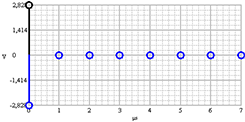
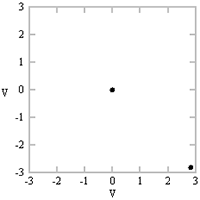
![Alternating QPSK symbols [1, -1], [-1, 1]](qpsk-alternating-symbols.png)
![Alternating QPSK symbols [1, -1], [-1, 1]](qpsk-constellation-alternating-symbols.png)
